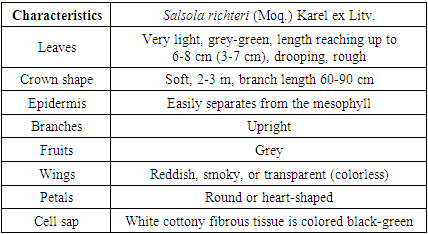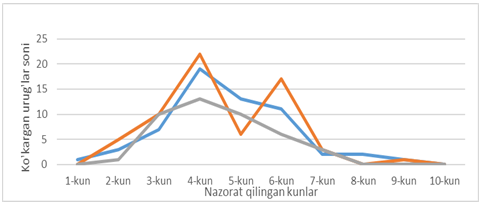-
Paper Information
- Previous Paper
- Paper Submission
-
Journal Information
- About This Journal
- Editorial Board
- Current Issue
- Archive
- Author Guidelines
- Contact Us
International Journal of Genetic Engineering
p-ISSN: 2167-7239 e-ISSN: 2167-7220
2024; 12(5): 68-70
doi:10.5923/j.ijge.20241205.03
Received: Jun. 25, 2024; Accepted: Jul. 17, 2024; Published: Jul. 20, 2024

Germination of Salsola Richteri (Moq.) Karel ex Litv. in the Conditions of Karakalpakstan
Karlibayeva M. A.1, Baltabayev M. T.2
1PhD Candidate, Department of Botany, Ecology and Teaching Methods, Nukus State Pedagogical Institute named after Ajiniyaz, Nukus, Uzbekistan
2Candidate of Biological Sciences, Associate Professor, Department of Botany, Ecology and Teaching Methods, Nukus State Pedagogical Institute named after Ajiniyaz, Nukus, Uzbekistan
Copyright © 2024 The Author(s). Published by Scientific & Academic Publishing.
This work is licensed under the Creative Commons Attribution International License (CC BY).
http://creativecommons.org/licenses/by/4.0/

The literature provides information on the conduct of phytomelioration works aimed at improving natural pastures and fodder bases in desert conditions, using local plant resources, studying the germination of their seeds, and cultivating plant species. In the deserts of Kyzylkum, Uzbekistan, two species of the genus Salsola, Salsola richteri (Moq.) Karel ex Litv. and Salsola paletzkiana Litv., are widely distributed. In the flora of Karakalpakstan, two species of the genus Salsola, Salsola richteri (Moq.) Karel ex Litv. and Salsola paletzkiana Litv., belonging to the Chenopodiaceae family of weeds, are prevalent. The growth of Salsola richteri (Moq.) Karel ex Litv. in open sands, its abundant fruiting, seed reproduction, and propagation by cuttings, salt tolerance, strong root system development, and the emergence of root suckers contribute to its role as the principal plant in stabilizing sands.
Keywords: Seed germination, Seed sprouting, Embryo, Cotyledons, Radicle, Sprouts, Fruitlet, Seeds, Scarification, Seed stratification, Growth and development, Sowing, Wild plants, Ovary, Seed viability, Storage life, At room temperature, Germination percentage, Seed survival, Soil germination, Sowing period
Cite this paper: Karlibayeva M. A., Baltabayev M. T., Germination of Salsola Richteri (Moq.) Karel ex Litv. in the Conditions of Karakalpakstan, International Journal of Genetic Engineering, Vol. 12 No. 5, 2024, pp. 68-70. doi: 10.5923/j.ijge.20241205.03.
1. Introduction
- Salsola richteri (Moq.) Karel ex Litv., also known as white Salsola, is a large-stemmed plant that can reach up to 3 meters in height. This sandy desert endemic plant of Central Asia features white, feather-like membranous and thin milky-white membranous branches that grow close to the ground. The leaves of Salsola richteri are arranged alternately, are roll-like, and cylindrical in shape, with small flowers (Table 1).
|
2. Materials and Methods
- The growth and germination of seeds in laboratory conditions were studied based on the methodological guidelines of M.G. Nikolaeva [7], M.K. Firsova [8], and others. Seeds were grown in Petri dishes at various temperatures. Observational studies were conducted on the width of the hypocotyl, length growth, and leaf formation during plant growth. Seed germination in soil conditions was studied by planting at different times and at various depths.To improve natural pastures and fodder bases in desert conditions, phytomeliorative work should be conducted, using resources from local plants and cultivating new plant species. Temperature is a primary factor in seed germination, closely related to biological and ecological characteristics and plays a significant role in forming life forms. When increasing the fodder base, the quality of the seeding materials plays a significant role. The quality of the seeding materials is primarily determined by the purity of the seeds, their germination, and classes.Laboratory germination is an indicator expressed as a percentage of the number of normally developing test seeds. The uniform growth of seeds is greatly influenced by the species density in the field, growth rate, and seed energy. All these indicators determine seed viability. Seed formation and survival depend on several factors, particularly meteorological conditions. In dry years, regeneration is observed in shrubby plants. Furthermore, Salsola richteri (Moq.) Karel ex Litv. is included in the national pharmacopoeia. The fruits and shoots contain alkaloids—salsolidine and salsoline, which are used for hypertension and severe neurological disorders [4].When comparing the laboratory germination of seeds collected on November 28, 2023, from the Northwest Kyzylkum with aridity (average annual temperature 14.9°C, relative humidity 51.2%, and annual precipitation norm of 95.2 mm), the germination rate was 7-21%. Meanwhile, seeds collected on November 20, 2021 (average annual temperature 12.5°C, relative humidity 31.9%, and annual precipitation norm of 103.6 mm) showed a germination rate of 16-32.2%. The slight difference in precipitation volumes demonstrates that meteorological conditions significantly impact seed germination. U. Japakova notes that the germination rate of Salsola richteri seeds under Kyzylkum conditions ranges from 8-12%, and that of Salsola paletzkiana is 3-16%, which is close to our figures [6].The germination rate of Salsola richteri seeds after 12 months is 9.6%, after 8 months it is 11%, and after 4 months it reaches 28.2% (Table 2). The germination of Richter's saltwort seeds drops sharply after 5 months of storage, so it is advisable to use recently collected seeds for sowing. It is practical to sow Salsola richteri (Moq.) Karel ex Litv. seeds in November and December.Thus, field germination directly depends on spring climatic conditions, soil fertility features, agronomic practices, and the physical-mechanical properties of the soil.
3. Results and Discussion
- Seed germination. To determine the laboratory germination of Salsola richteri seeds, we collected seeds in the fall of 2023 from Salsola richteri growing around the city of Nukus in the Northwest Kyzylkum (from the place where it grew in roadside sand). We placed 100 seeds in a Petri dish and repeated the experiment three times at temperatures of 18-23°C, achieving a seed germination rate of 32.2%. In laboratory experiments, Salsola richteri seeds germinate within 3-6 days.In laboratory conditions, we took seed wings of Salsola richteri and conducted an experiment. Seeds germinated over 1-9 days, with high germination observed on days 3-4 (Table 2).
|
|
|
4. Conclusions
- Therefore, it is advisable to sow Salsola richteri in November and December. In field conditions, germination rates can vary depending on the sowing rate. With an increase in sowing rates, germination in field conditions also increases.The reason that seed germination in field conditions is lower compared to laboratory germination is due to the drastic change in growth conditions for the seeds. In the laboratory, conditions are optimized for germination. When seeds grow in the field, the circumstances are quite different; in this case, the temperature, moisture regimes, and lighting differ from laboratory conditions. In field conditions, seeds must not only grow but also emerge through the soil surface.Thus, field germination directly depends on spring weather conditions, soil fertility, agricultural techniques, and the physical-mechanical properties of the soil.
 Abstract
Abstract Reference
Reference Full-Text PDF
Full-Text PDF Full-text HTML
Full-text HTML


